Using the RESC Model and Diversity Indexes to Assess the Cross-Scale Water Resource Vulnerability and Spatial Heterogeneity in the Huai River Basin, China
Abstract
:1. Introduction
2. Materials and Methods
2.1. Study Area
2.2. Data
2.3. Methodology
2.3.1. Assessment of the Sensitivity and Water Resource Vulnerability Based on the RESC Model
2.3.2. Heterogeneity Assessment of Water Resource Vulnerability
Multiscale Design Study
- Water Resources Regions (WRRs): They contain different classes, essentially considered as river basins or groups of basins, and were most commonly used as large-scale watershed-based regions in past studies. In this paper, the WRR mainly refers to the Class I WRRs: the Huai River Basin.
- Class II WRRs: These comprise a naturally defined system under the scale of Class I WRRs, and commonly present the upper, middle, lower, and the main branch of the total basin. Class II WRRs are either large river basins or contiguous smaller basins with common characteristics.
- Class III WRRs: These are used as fine-scale watershed-based regions that are affected by artificial plant systems or natural boundaries between different agriculture irrigation systems, which change the storage and through-put of the surface flow.
Quantification of Heterogeneity
3. Results
3.1. Water Resource Vulnerability of Class II and Class III WRRs
3.2. Spatial Differences of Water Resource Vulnerability at the Province-Class II WRR Scale
3.3. Spatial Differences in Water Resource Vulnerabilities at the Municipality-Class III WRR Scale
3.4. Heterogeneity Quantification of Water Resource Vulnerability
4. Discussion
4.1. Deductive Presentation of How the RESC Model Works
4.2. Heterogeneity Signifies the Diversity of Water Resource Vulnerability and Demonstrates Potential for Application in the Relevant Authority Departments
4.3. An Appropriate Scale Depending on the Objectives and Water Resource Districts
4.4. Uncertainty Analysis
5. Conclusions
Acknowledgments
Author Contributions
Conflicts of Interest
Abbreviations
| Class II WRRs | second-class water resource regions |
| Class III WRRs | third-class water resource regions |
| HRB | Huai River Basin |
| UHR | Upper Huai River |
| MHR | Middle reaches of the Huai River |
| LHR | Lower reaches of the Huai River |
| YSSR | Yi-Shu-Si River |
References
- Albinet, M.; Margat, J. Mapping the vulnerability to pollution of groundwater aquifers. In Groundwater Pollution-Symposium-Pollution des Eaux Souterraines; IAHS-AISH: Wallingford, UK, 1970; Volume 103, pp. 58–70. [Google Scholar]
- Hashimoto, T.; Loucks, D.; Stedinger, J. Reliability, resiliency and vulnerability criteria for water resources systems. Water Resour. Res. 1982, 18, 14–20. [Google Scholar] [CrossRef]
- The Intergovernmental Panel on Climate Change (IPCC). Climate Change 1995: The Science of Climate Change; Cambridge University Press: Cambridge, UK, 1996; Volume 19390. [Google Scholar]
- Falkenmark, M.; Widstrand, C. Population and Water Resources: A Delicate Balance; Population Reference Bureau: Washington, DC, USA, 1992; pp. 1–36. [Google Scholar]
- Raskin, P.; Gleick, P.; Kirshen, P.; Pontius, G.; Strzepek, K. Water Futures: Assessment of Long-Range Patterns and Prospects; Stockholm Environment Institute (SEI): Stockholm, Sweden, 1997. [Google Scholar]
- Alcamo, J.; Döll, P.; Kaspar, F.; Siebert, S. Global Change and Global Scenarios of Water Use and Availability: An Application of WaterGap 1.0; Center for Environmental Systems Research (CESR), University of Kassel: Kassel, Germany, 1997; pp. 17–20. [Google Scholar]
- The Intergovernmental Panel on Climate Change (IPCC). Managing the Risks of Extreme Events and Disasters to Advance Climate Change Adaptation: A Special Report of Working Groups I and II of the Intergovernmental Panel on Climate Change; Cambridge University Press: Cambridge, UK, 2012. [Google Scholar]
- Vorosmarty, C.J.; Green, P.; Salisbury, J.; Lammers, R.B. Global water resources: Vulnerability from climate change and population growth. Science 2000, 289, 284–288. [Google Scholar] [CrossRef] [PubMed]
- Blöschl, G.; Sivapalan, M. Scale issues in hydrological modelling: A review. Hydrol. Process. 1995, 9, 251–290. [Google Scholar] [CrossRef]
- Mandelbrot, B.B. How long is the coast of Britain. Science 1967, 156, 636–638. [Google Scholar] [CrossRef] [PubMed]
- Wu, J. Effects of changing scale on landscape pattern analysis: Scaling relations. Landsc. Ecol. 2004, 19, 125–138. [Google Scholar] [CrossRef]
- Barry, S.; Wandel, J. Adaptation, adaptive capacity and vulnerability. Glob. Environ. Chang. Hum. Policy Dimens. 2006, 16, 282–292. [Google Scholar]
- Xia, J.; Chen, J.; Weng, J.; Yu, L.; Qi, J.; Liao, Q. Water resource vulnerability and its spatial heterogeneity in Haihe River Basin, China. Chin. Geogr. Sci. 2014, 24, 525–539. [Google Scholar] [CrossRef]
- Zhou, J.; Zou, J. Vulnerability assessment of water resources to climate change in Chinese cities. Ecol. Econ. 2010, 6, 106–114. [Google Scholar]
- Liu, C. The Vulnerability of Water Resources in Northwest China. J. Glaciol. Geocryol. 2003, 3, 309–314. [Google Scholar]
- Hamouda, M.A.; El-Din, M.M.N.; Moursy, F.I. Vulnerability assessment of water resources systems in the Eastern Nile Basin. Water Resour. Manag. 2009, 23, 2697–2725. [Google Scholar] [CrossRef]
- Gain, A.K.; Giupponi, C.; Renaud, F.G. Climate Change Adaptation and Vulnerability Assessment of Water Resources Systems in Developing Countries: A Generalized Framework and a Feasibility Study in Bangladesh. Water 2012, 4, 345–366. [Google Scholar] [CrossRef] [Green Version]
- Hewitt, J.E.; Thrush, S.F.; Dayton, P.K.; Bonsdorff, E. The effect of spatial and temporal heterogeneity on the design and analysis of empirical studies of scale-dependent systems. Am. Nat. 2007, 169, 398–408. [Google Scholar] [CrossRef] [PubMed]
- Pulliam, H.R.; Dunning, J.B. The influence of food supply on local density and diversity of sparrows. Ecology 1987, 68, 1009–1014. [Google Scholar] [CrossRef]
- Schulze, R. Transcending scales of space and time in impact studies of climate and climate change on agrohydrological responses. Agric. Ecosyst. Environ. 2000, 82, 185–212. [Google Scholar] [CrossRef]
- Liu, C.; Zhang, D.; Liu, X.; Zhao, C. Spatial and temporal change in the potential evapotranspiration sensitivity to meteorological factors in China (1960–2007). J. Geogr. Sci. 2012, 22, 3–14. [Google Scholar] [CrossRef]
- China People’s Congress. Water Law of the People’s Republic of China (Amended); Law Press: Beijing, China, 2002.
- Shen, D. The 2002 Water Law: Its impacts on river basin management in China. Water Policy 2004, 6, 345–364. [Google Scholar]
- Chen, P.; Li, L.; Zhang, H. Spatio-Temporal Variations and Source Apportionment of Water Pollution in Danjiangkou Reservoir Basin, Central China. Water 2015, 7, 2591–2611. [Google Scholar] [CrossRef]
- Cheng, H.F.; Hu, Y.A. Improving China’s water resources management for better adaptation to climate change. Clim. Chang. 2012, 112, 253–282. [Google Scholar] [CrossRef]
- Xie, P.; Chen, M.; Yang, S.; Yatagai, A.; Hayasaka, T.; Fukushima, Y.; Liu, C. A gauge-based analysis of daily precipitation over East Asia. J. Hydrometeorol. 2007, 8, 607–626. [Google Scholar] [CrossRef]
- Ying, X.; Xuejie, G.; Yan, S.; Chonghai, X.; Ying, S. A daily temperature dataset over China and its application in validating a RCM simulation. Adv. Atmos. Sci. 2009, 26, 763–772. [Google Scholar]
- Fu, G.B.; Charles, S.P.; Chiew, F.H.S. A two-parameter climate elasticity of streamflow index to assess climate change effects on annual streamflow. Water Resour. Res. 2007, 43, W11419. [Google Scholar] [CrossRef]
- Chen, J.; Xia, J.; Zhao, C.; Zhang, S.; Fu, G.; Ning, L. The mechanism and scenarios of how mean annual runoff varies with climate change in Asian monsoon areas. J. Hydrol. 2014, 517, 595–606. [Google Scholar] [CrossRef]
- Gardner, L.R. Assessing the effect of climate change on mean annual runoff. J. Hydrol. 2009, 379, 351–359. [Google Scholar] [CrossRef]
- Brouwer, F.; Falkenmark, M. Climate-induced water availability changes in Europe. Environ. Monit. Assess. 1989, 13, 75–98. [Google Scholar] [CrossRef] [PubMed]
- Zhao, C.; Liu, C.; Xia, J.; Zhang, Y.; Yu, Q.; Eamus, D. Recognition of key regions for restoration of phytoplankton communities in the Huai River basin, China. J. Hydrol. 2012, 420, 292–300. [Google Scholar] [CrossRef]
- Wiens, J.A. Spatial scaling in ecology. Funct. Ecol. 1989, 3, 385–397. [Google Scholar] [CrossRef]
- Perveen, S.; James, L.A. Scale invariance of water stress and scarcity indicators: Facilitating cross-scale comparisons of water resource vulnerability. Appl. Geogr. 2011, 31, 321–328. [Google Scholar] [CrossRef]
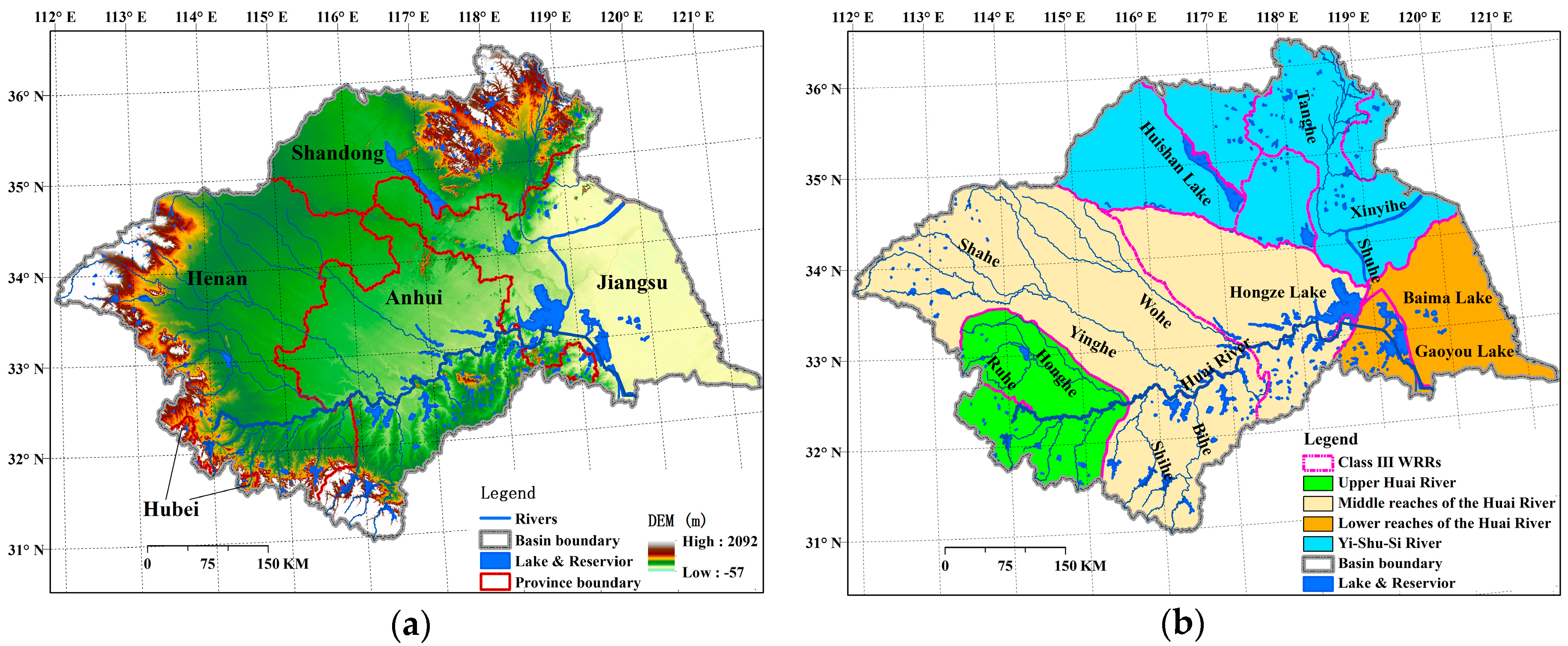
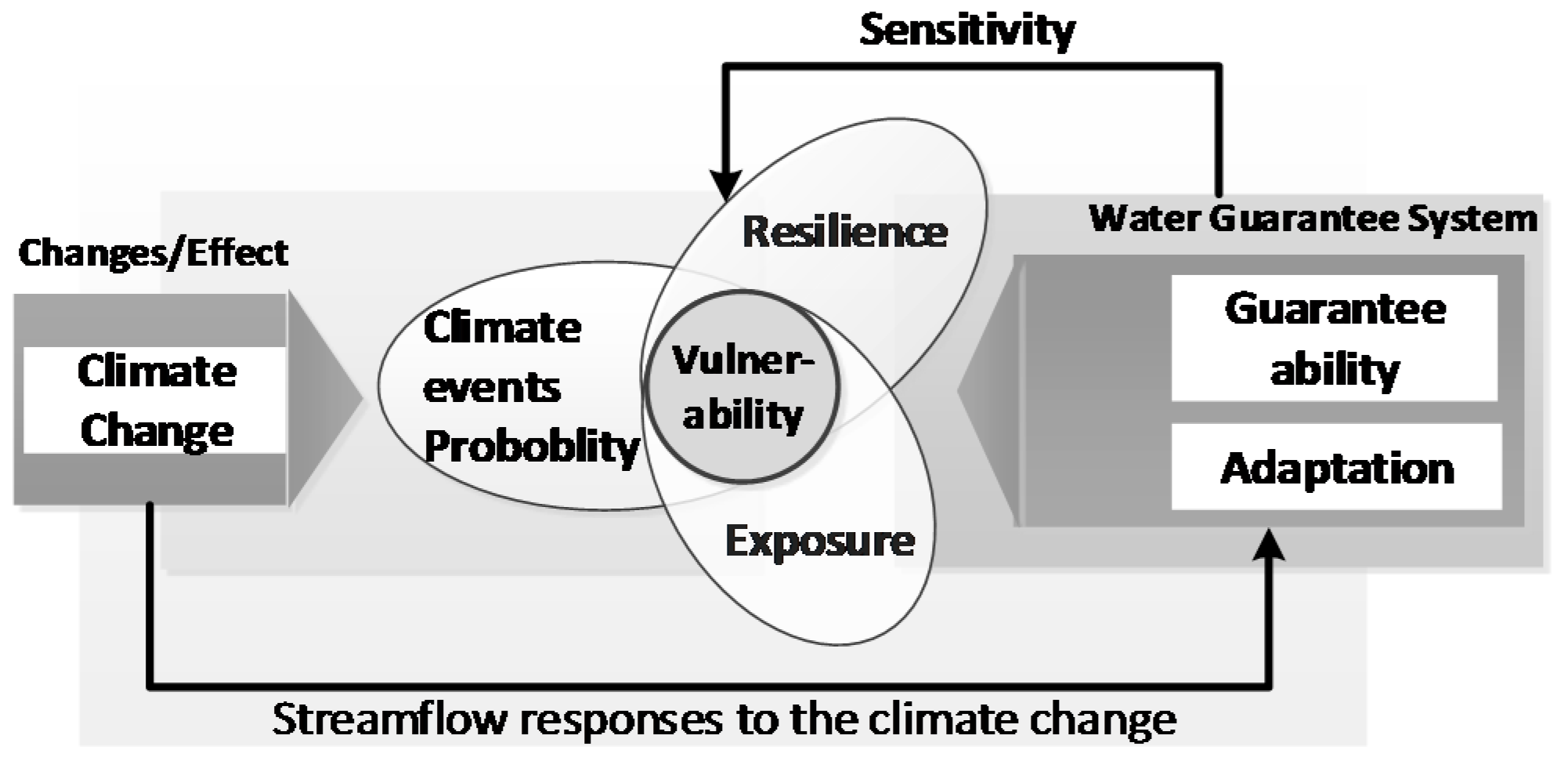



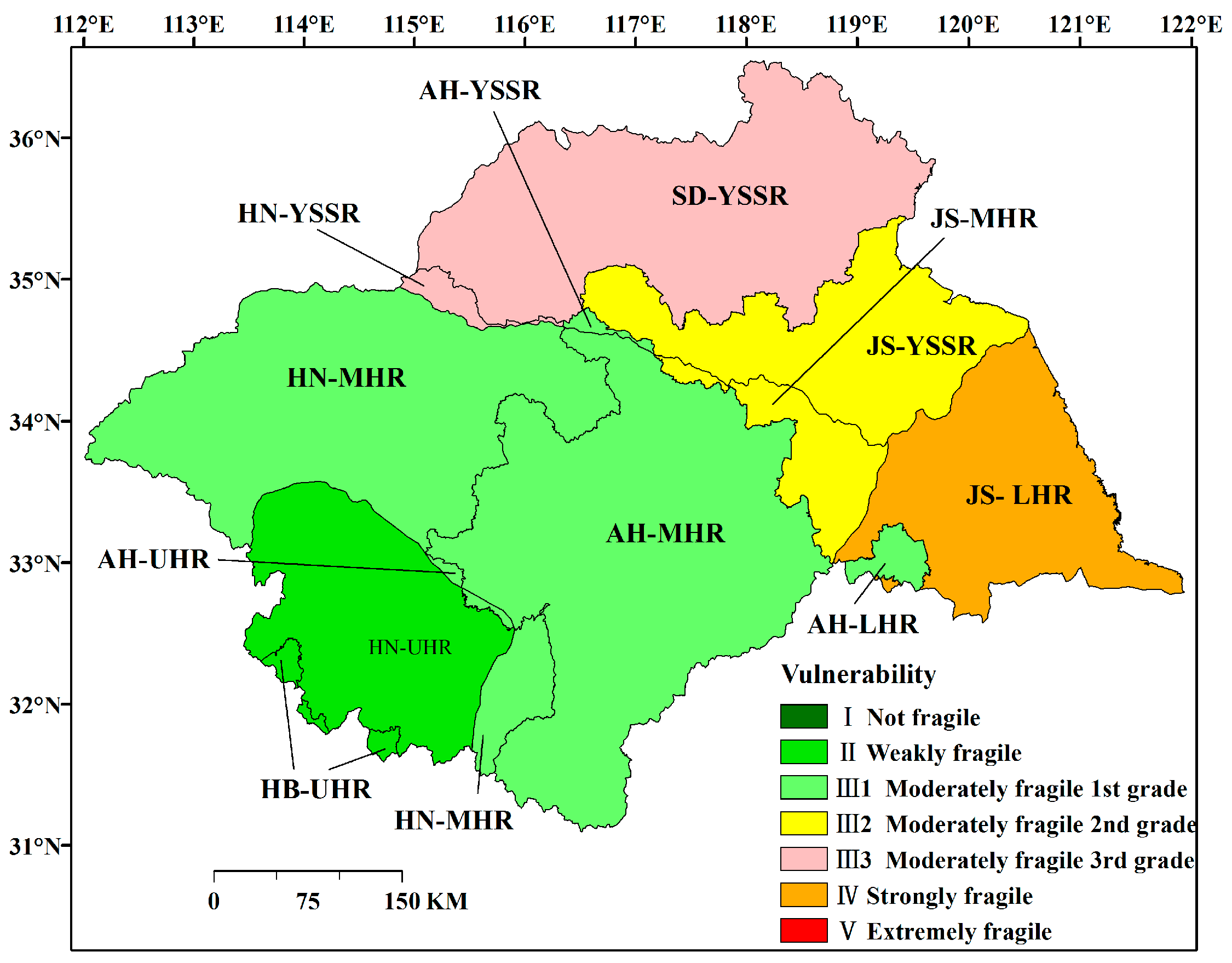

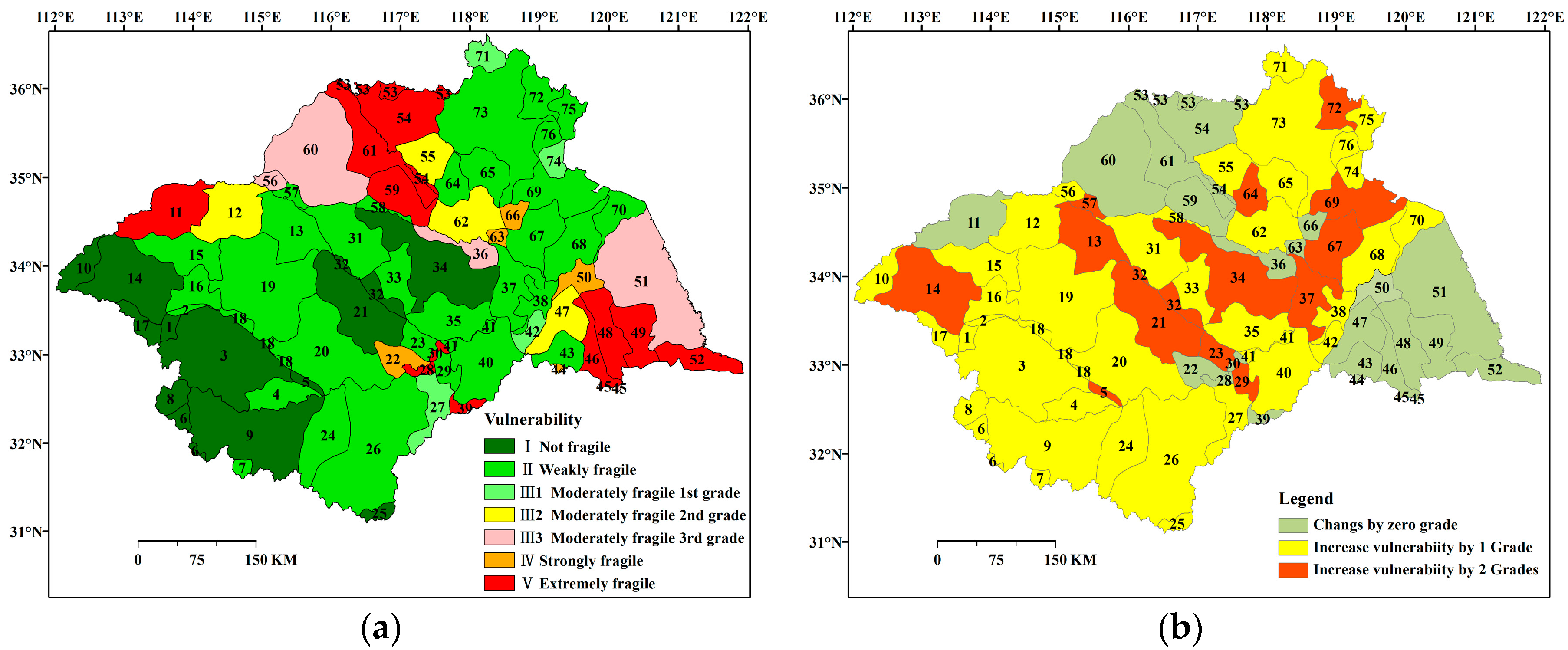
 ) sign represents the appropriate employed situations for certain vulnerability results on a scale. The (
) sign represents the appropriate employed situations for certain vulnerability results on a scale. The (  ) sign represents the downscale arrows.
) sign represents the downscale arrows.
 ) sign represents the appropriate employed situations for certain vulnerability results on a scale. The (
) sign represents the appropriate employed situations for certain vulnerability results on a scale. The (  ) sign represents the downscale arrows.
) sign represents the downscale arrows.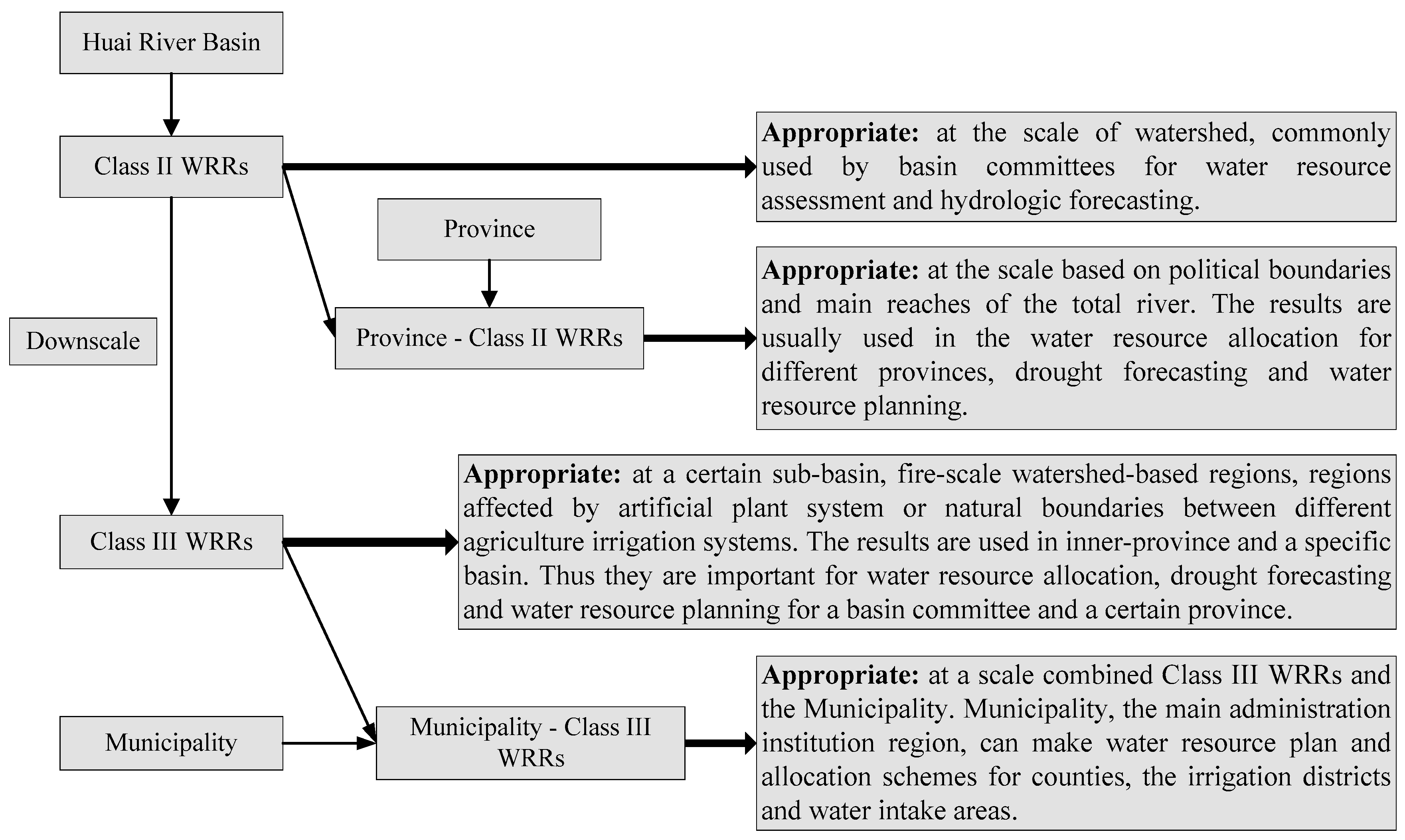
| Variable | Area (km2) | Average Water Resources (1956–2000) (108 m3) | Water Consumption in 2000 (108 m3) | GDP (108 Yuan) | Population (104 Person) | |
|---|---|---|---|---|---|---|
| Region | ||||||
| UHR | 30,588 | 121.1 | 28.66 | 510.3 | 1390.2 | |
| MHR | 128,784 | 374.4 | 199.86 | 3795.3 | 8185.9 | |
| LHR | 30,660 | 93.1 | 107.13 | 1300.6 | 1728.5 | |
| YSSR | 78,925 | 210.8 | 165.02 | 2867.7 | 5051.2 | |
| Total | 268,957 | 799.4 | 500.67 | 8473.9 | 16,356.6 | |
| V(t) | Class | Subclass | Description |
|---|---|---|---|
| 0 ≤ V(t) ≤ 0.10 | I | – | Not fragile |
| 0.10 < V(t) ≤ 0.20 | II | – | Weakly fragile |
| 0.20 < V(t) ≤ 0.60 | III | – | Moderately fragile |
| 0.20 < V(t) ≤ 0.30 | – | III1 | Moderately fragile, 1st grade |
| 0.30 < V(t) ≤ 0.40 | – | III2 | Moderately fragile, 2nd grade |
| 0.40 < V(t) ≤ 0.60 | – | III3 | Moderately fragile, 3rd grade |
| 0.60 < V(t) ≤ 0.80 | IV | – | Strongly fragile |
| V(t) > 0.80 | V | – | Extremely fragile |
| Index | Not | Weak | Moderate | Strong | Extreme | Theil Index | Shannon-Weaver Index | |||
|---|---|---|---|---|---|---|---|---|---|---|
| Region | 1st | 2nd | 3rd | |||||||
| Class II WRRs | 0 | 1 | 1 | 1 | 1 | 0 | 0 | 0.560 | 1.040 | |
| Class III WRRs | 0 | 2 | 3 | 5 | 0 | 1 | 2 | 0.467 | 1.525 | |
| Province-Class II WRRs | 0 | 2 | 5 | 2 | 2 | 1 | 0 | 0.478 | 1.545 | |
| Municipality-Class III WRRs | 0 | 9 | 27 | 14 | 9 | 3 | 14 | 0.322 | 1.685 | |
© 2016 by the authors; licensee MDPI, Basel, Switzerland. This article is an open access article distributed under the terms and conditions of the Creative Commons Attribution (CC-BY) license (http://creativecommons.org/licenses/by/4.0/).
Share and Cite
Chen, J.; Xia, J.; Zhao, Z.; Hong, S.; Liu, H.; Zhao, F. Using the RESC Model and Diversity Indexes to Assess the Cross-Scale Water Resource Vulnerability and Spatial Heterogeneity in the Huai River Basin, China. Water 2016, 8, 431. https://doi.org/10.3390/w8100431
Chen J, Xia J, Zhao Z, Hong S, Liu H, Zhao F. Using the RESC Model and Diversity Indexes to Assess the Cross-Scale Water Resource Vulnerability and Spatial Heterogeneity in the Huai River Basin, China. Water. 2016; 8(10):431. https://doi.org/10.3390/w8100431
Chicago/Turabian StyleChen, Junxu, Jun Xia, Zhifang Zhao, Si Hong, Hong Liu, and Fei Zhao. 2016. "Using the RESC Model and Diversity Indexes to Assess the Cross-Scale Water Resource Vulnerability and Spatial Heterogeneity in the Huai River Basin, China" Water 8, no. 10: 431. https://doi.org/10.3390/w8100431






